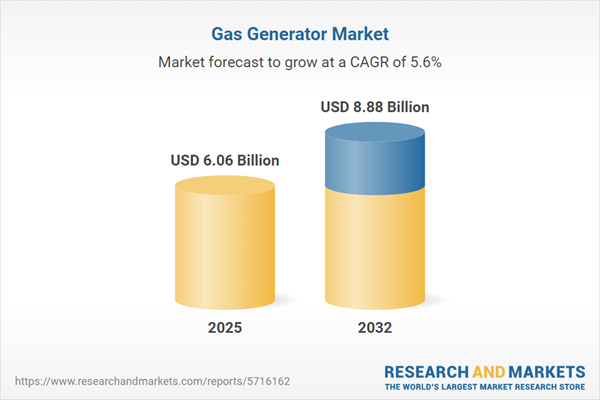Speak directly to the analyst to clarify any post sales queries you may have.
In today’s environment of growing operational complexity and rising energy unpredictability, the gas generator market stands out as a foundational resource for organizations seeking consistent, reliable power. Senior executives are increasingly turning to gas generator solutions to advance business continuity and support resilient infrastructure planning across sectors.
Market Snapshot: Gas Generator Market Size and Growth Outlook
The global gas generator market is experiencing steady and reliable growth, with projections indicating expansion from USD 5.74 billion in 2024 to USD 6.06 billion in 2025 and a further rise to USD 8.88 billion by 2032, reflecting a compound annual growth rate of 5.60%. This marketplace is propelled by robust demand for dependable backup power as infrastructure becomes more complex in critical sectors such as healthcare and data management. Trends such as accelerated urbanization, evolving reliability standards, and rapidly shifting regulatory landscapes fuel ongoing market adoption. Regional disparities arise from regulatory frameworks, procurement habits, and investment focus, creating a market defined by technological advancement and application in business-critical settings.
Scope & Segmentation: Strategic Segments in the Gas Generator Market
This comprehensive report addresses the essential dimensions of the gas generator market, enabling leaders to align product acquisition and infrastructure with operational continuity strategies. Each segment mapped here is significant in shaping procurement priorities and long-term investments.
- Product Types: Peak shaving generators minimize stress on grids during demand surges; portable units provide versatile power for dynamic applications; prime power systems are designed for sustained operation; and standby models deliver dedicated backup for sensitive or high-stakes environments.
- Fuel Types: Choices include bi-fuel solutions for flexibility, diesel for established use cases, LPG for cleaner combustion, and natural gas options that support evolving sustainability criteria and compliance needs.
- Power Ratings: Options range from units intended for residential reliability to high-capacity systems that support industrial, construction, and enterprise-scale demands.
- End Uses: Principal application areas span healthcare, data centers, manufacturing, retail operations, construction projects, and modern residential zones, each requiring assurance of service continuity and compliance with industry mandates.
- Sales Channels: Sourcing spans direct procurement for greater control, OEM agreements for integration, distributor networks for broad access, and digital platforms for procurement efficiency—tailored to an organization’s scale and support needs.
- Regions: Market segmentation encompasses the Americas, Europe, Middle East and Africa, and Asia-Pacific, reflecting variations in infrastructure readiness, policy influence, and investment strategies that guide local expansion and product positioning.
- Leading Manufacturers: Industry standards are set by General Electric, Caterpillar, Cummins, Siemens Energy, Mitsubishi Heavy Industries, Rolls-Royce Power Systems, Wärtsilä, Doosan Enerbility, Kawasaki Heavy Industries, and MAN Energy Solutions through ongoing technological and reliability advancements.
Key Takeaways: Strategic Insights for Senior Decision-Makers
- Gas generators play a crucial role in managing power instability, especially for critical sectors where continuity cannot be compromised.
- Integration with renewable assets helps organizations meet modern ESG and environmental compliance goals by supporting hybrid energy architectures.
- Advanced monitoring and automation technologies significantly boost operational efficiency and enable proactive maintenance, reducing downtime and protecting key assets.
- Procurement strategies are influenced by environmental and sustainability criteria, aligning purchasing with regulatory initiatives and transitioning toward lower-emission operations.
- Modular and scalable generator designs support a range of applications, allowing organizations to efficiently expand or adapt infrastructure to evolving operational demands in diverse settings.
- Regional service agreements and robust maintenance support are vital for rapid response and enhanced reliability in critical applications across multiple industries.
Tariff Impact: Sourcing Strategies for 2025
As U.S. tariff reforms approach, organizations are reassessing supply chain and procurement strategies to maintain compliance and secure uninterrupted operations. The focus on domestic resilience and cost management is shaping leadership decisions within a shifting policy context.
Methodology & Data Sources
The analysis integrates quantitative data from sector studies, regulatory documentation, patent analytics, and qualitative insights from in-depth stakeholder interviews. This approach delivers balanced, actionable guidance for organizations evaluating the gas generator market.
Why This Report Matters: Executive Decision Support
- Presents detailed market segmentation and benchmarks, empowering leaders to shape procurement choices and allocate capital effectively.
- Improves organizational risk management by supporting adaptable contingency planning amid fluctuating energy sector dynamics.
- Simplifies compliance through clear regulatory navigation tools, assisting decision-makers in responding promptly to shifting standards.
Conclusion
Gas generators remain central to ensuring operational resilience and mitigating power-related risk. With this market intelligence, decision-makers can confidently advance business continuity strategies in a landscape shaped by new energy demands.
Additional Product Information:
- Purchase of this report includes 1 year online access with quarterly updates.
- This report can be updated on request. Please contact our Customer Experience team using the Ask a Question widget on our website.
Table of Contents
3. Executive Summary
4. Market Overview
7. Cumulative Impact of Artificial Intelligence 2025
Companies Mentioned
The companies profiled in this Gas Generator market report include:- General Electric Company
- Siemens Energy AG
- Mitsubishi Heavy Industries, Ltd.
- Caterpillar Inc.
- Cummins Inc.
- Rolls-Royce Power Systems AG
- Wärtsilä Corporation
- Kawasaki Heavy Industries, Ltd.
- MAN Energy Solutions SE
- Doosan Enerbility Co., Ltd.
Table Information
| Report Attribute | Details |
|---|---|
| No. of Pages | 196 |
| Published | October 2025 |
| Forecast Period | 2025 - 2032 |
| Estimated Market Value ( USD | $ 6.06 Billion |
| Forecasted Market Value ( USD | $ 8.88 Billion |
| Compound Annual Growth Rate | 5.6% |
| Regions Covered | Global |
| No. of Companies Mentioned | 11 |









